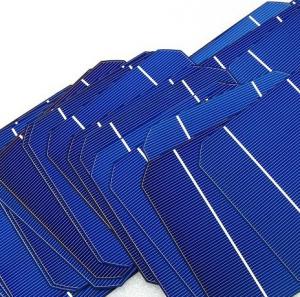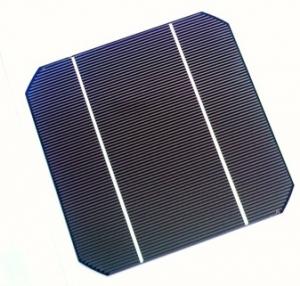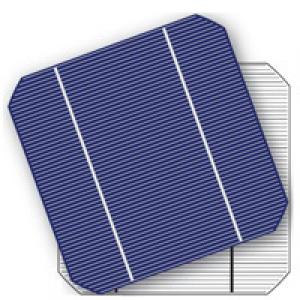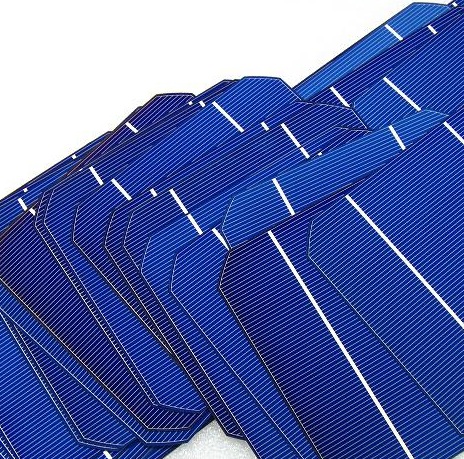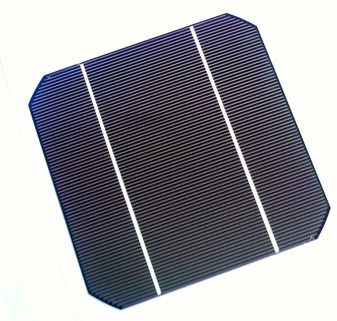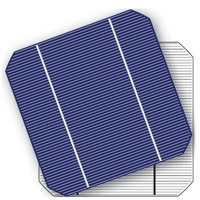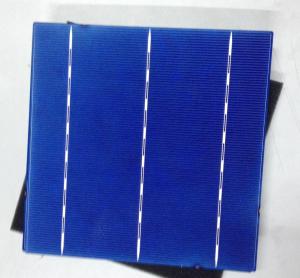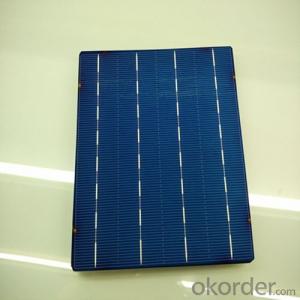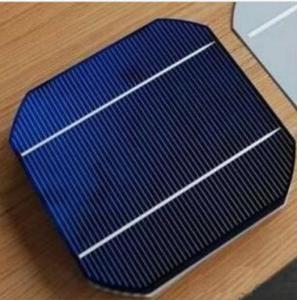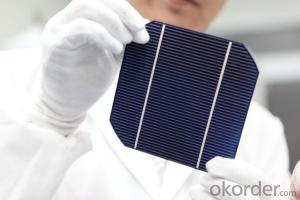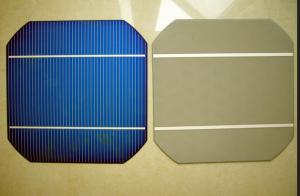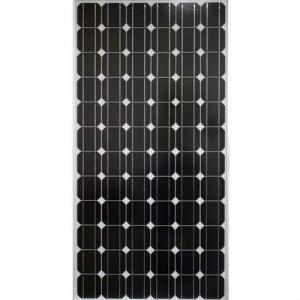Mono Silicon Solar Cells - 3D Monocrystalline Solar Cells for Tire Manufacturers
- Loading Port:
- Shanghai
- Payment Terms:
- TT or LC
- Min Order Qty:
- 10000 pc
- Supply Capability:
- 50000000 pc/month
OKorder Service Pledge
OKorder Financial Service
You Might Also Like
Specifications of Mono Solar Cells
Format : 156 mm × 156 mm ± 0.5 mm
Thickness: 210 μm ±40 μm
Front (-) : 1.5mm bus bars (silver),blue anti-reflection coating (silicon nitride)
Back (+) : 2.5mm wide soldering pads (silver) back surface field (aluminium)
Electrical Characteristic of Mono Solar Cells
Efficiency (%) | Pmpp (W) | Umpp (V) | Impp (A) | Uoc (V) | Isc (A) | FF (%) |
18.35 | 4.384 | 0.526 | 8.333 | 0.63 | 8.877 | 78.39% |
18.20 | 4.349 | 0.526 | 8.263 | 0.63 | 8.789 | 78.54% |
18.05 | 4.313 | 0.525 | 8.216 | 0.63 | 8.741 | 78.32% |
17.90 | 4.277 | 0.524 | 8.161 | 0.629 | 8.713 | 78.04% |
17.75 | 4.241 | 0.523 | 8.116 | 0.629 | 8.678 | 77.70% |
17.60 | 4.206 | 0.521 | 8.073 | 0.628 | 8.657 | 77.36% |
17.45 | 4.170 | 0.519 | 8.039 | 0.628 | 8.633 | 76.92% |
17.30 | 4.134 | 0.517 | 8.004 | 0.626 | 8.622 | 76.59% |
17.15 | 4.098 | 0.516 | 7.938 | 0.625 | 8.537 | 76.80% |
17.00 | 4.062 | 0.512 | 7.933 | 0.625 | 8.531 | 76.18% |
16.75 | 4.002 | 0.511 | 7.828 | 0.625 | 8.499 | 75.34% |
16.50 | 3.943 | 0.510 | 7.731 | 0.625 | 8.484 | 74.36% |
Advantage of Mono Solar Cells
1. High efficiency and High power.
2. Long-term electrical stability.
3. Lowest price and Fastest delivery.
4. Good quality and best service.
5. Bulk supply
6. Trusted Warranty
7. Big Sale
8. More than 25 years on the lifetime.
Usage and Applications of Mono Solar Cells
Solar cells are often electrically connected and encapsulated as a module. Photovoltaic modules often have a sheet of glass on the front (sun up) side, allowing light to pass while protecting the semiconductor wafers from abrasion and impact due to wind-driven debris, rain, hail, etc. Solar cells are also usually connected in series in modules, creating an additive voltage. Connecting cells in parallel will yield a higher current;our solar cells have passed IEC Certification. With high quality and stable quality. Our Cells can greatly improve the performance of Solar Modules.
Packaging & Delivery of Mono Solar Cells
Carton Box Package and Deliver by air. It should be noticed that it should be avoid of water, sunshine and moist.
Factory Picture of Solar Cells
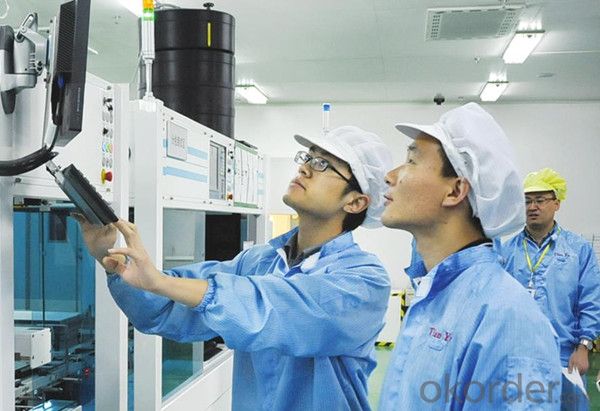
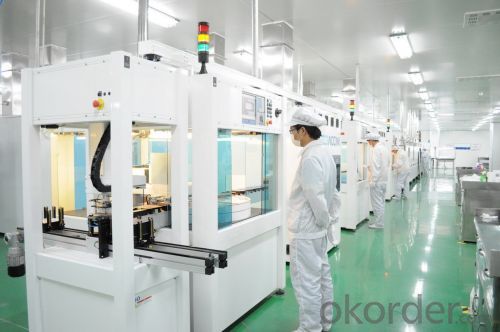
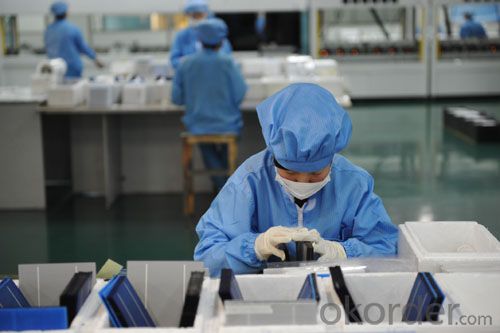
FAQ
We have organized several common questions for our clients,may help you sincerely:
A: It’s depends on the quantity, delivery date and payment terms of the order. We can talk further about the detail price issue. Our products is high quality with lower price level.
We have different series of cells with different power output, both from c-si to a-si. Please take our specification sheet for your reference.
We have rich experience on how to pack the panels to make sure the safety on shipment when it arrives at the destination.
Yes, we can.
In the purchase of product within three working days, We will arrange the factory delivery as soon as possible. The perfect time of receiving is related to the state and position of customers. Commonly 7 to 10 working days can be served.
Rumors about 3d solar cell manufacturers
Whether all 3d solar cell manufacturers are at a loss?
Truth: Some 3d solar cell manufacturers at a loss, but not all are so. Many silicon solar cell manufacturers with the same technology in the same field of competition, leading them the more difficult situation. Other areas are more profitable, such as films, elastic and lightweight solar panels fields.
With the rapid changes in business and market leadership, the 3d solar cell industry is still immature. Today we see is a traditional period of consolidation of a new industry, there are winners and losers, but the surviving players will usher in a bright and lucrative future.
In the next winner, there will be those companies of the roof and the building, because they insight into BIPV must be a rising star. Solar cells will be better integrated into the roofs and facades. The current building materials manufacturers in this field will gain market-share opportunity.
Prospects of 3d solar cell manufacturers
Solar is already a highly cost-competitive energy. Cheap, efficient batteries will certainly enhance the attractiveness, but in fact, the most abundant solar energy in sunlight, when the production of electricity, which makes it less dependent on energy compared to other energy storage solutions. In the long run, with the improvement of solar cell manufacturing technology and new light - electric conversion means the protection of inventions, national environmental and regeneration of the huge demand for clean energy, solar cells will continue to use solar radiation more practical and feasible the method can open up broad prospects for large-scale use of solar energy for the human future.
2009-2013, China's 3d solar cell production increased year by year, in which the Chinese solar cell production in 2010 increased by 117.04%, the largest increase in recent years; in 2012, China's solar cell production growth decline, only 14.11%; 2013 China cell production further expand the scale, capacity of 42GW, production reached 25.1GW. Compared with 2012, the growth rate of about 20%, production accounts for about 62% of the global total, ranking first in the world. At present, China has become the world's leading producer of 3d solar cells.
China has already overtaken Europe, Japan, being the largest world's solar cell manufacturing superpower. In the industrial layout, China's 3d solar cell industry has formed a certain gathering momentum. In the Yangtze River Delta, the Bohai Sea, the Pearl River Delta, Midwest, it has formed a unique solar energy industry cluster. By 2030, it is possible to achieve the cost of solar power down to the level of wind power.
- Q: How do solar cells impact water resources?
- Solar cells do not directly impact water resources as they generate electricity from sunlight, which does not require water. However, the production and manufacturing processes of solar cells may require water, but it is relatively minimal compared to other forms of energy generation like fossil fuels or nuclear power.
- Q: How do solar cells perform in high altitude environments?
- Solar cells perform better in high altitude environments due to several factors. Firstly, at higher altitudes, there is less atmospheric interference, resulting in reduced scattering and absorption of sunlight. This allows solar cells to receive more direct and intense sunlight, increasing their efficiency. Secondly, the lower temperatures at higher altitudes help solar cells operate more efficiently as they generate less heat, reducing the risk of overheating. Finally, the thinner air at higher altitudes allows for better heat dissipation, further enhancing the performance and lifespan of solar cells. Therefore, solar cells are generally more effective and efficient in high altitude environments.
- Q: What is the impact of pollution or smog on solar cell performance?
- The impact of pollution or smog on solar cell performance is significant. Pollutants in the air, such as particulate matter and chemicals, can accumulate on the surface of solar panels, reducing their efficiency by blocking or scattering sunlight. This leads to a decrease in the amount of electricity generated by the solar cells. Smog, which is a combination of smoke and fog, can further exacerbate the problem by reducing the amount of sunlight reaching the solar panels. Overall, pollution and smog can significantly hamper the performance of solar cells, resulting in lower energy production.
- Q: How do solar cells perform in high altitude regions?
- Solar cells perform more efficiently in high altitude regions due to several factors. Firstly, high altitudes often have less air pollution, which means there are fewer particles in the air that can block or scatter sunlight. This allows solar cells to receive more direct sunlight, resulting in increased energy production. Additionally, solar cells operate more efficiently at lower temperatures, and high altitudes generally have cooler temperatures compared to lower elevations. Cooler temperatures help to reduce heat-related losses and improve the overall performance of solar cells. Therefore, solar cells in high altitude regions tend to generate more electricity and have higher conversion rates.
- Q: Can solar cells be used in boats or marine applications?
- Yes, solar cells can definitely be used in boats or marine applications. They provide a sustainable and renewable source of energy to power various systems onboard, such as navigation equipment, lighting, battery charging, and even propulsion systems. Solar panels can be installed on the deck or roof of a boat, where they can harness the sun's energy to generate electricity and reduce reliance on fossil fuels.
- Q: Can solar cells be used to power air conditioning systems?
- Yes, solar cells can be used to power air conditioning systems. However, the efficiency and capacity of the solar cells, as well as the size of the air conditioning system, need to be considered to ensure sufficient power supply.
- Q: What is the impact of solar cells on job creation?
- The impact of solar cells on job creation is significant. The solar industry has seen a rapid growth in recent years, leading to a surge in job opportunities. Solar cell manufacturing, installation, maintenance, and research and development have all created a wide range of employment opportunities. This growth has not only created jobs in the renewable energy sector but has also generated indirect employment in related industries. Additionally, the shift towards solar energy has encouraged innovation and entrepreneurship, further contributing to job creation. Overall, solar cells have had a positive impact on job creation by driving economic growth and fostering a sustainable workforce.
- Q: What is the effect of dust or dirt on solar cell performance?
- The presence of dust or dirt on solar cells can significantly reduce their performance by blocking sunlight from reaching the cells, thereby reducing their efficiency in converting sunlight into electricity. The dust or dirt particles act as a barrier, preventing the photons from reaching the semiconductor material within the solar cells. This decreases the amount of electricity generated, resulting in a decrease in overall power output. Therefore, regular cleaning and maintenance of solar panels is essential to maximize their performance and ensure optimal energy production.
- Q: Can solar cells be used in residential applications?
- Yes, solar cells can be used in residential applications. They are commonly used to generate electricity for homes, providing a clean and renewable energy source. Solar panels are installed on rooftops or in yards, capturing sunlight and converting it into usable electricity for various household needs. This helps reduce reliance on traditional power grids and lowers carbon emissions, making it an environmentally friendly and cost-effective solution for residential energy needs.
- Q: Can solar cells be used for powering hotels?
- Yes, solar cells can be used for powering hotels. Solar cells, also known as photovoltaic cells, convert sunlight into electricity, providing a sustainable and renewable energy source. By installing solar panels on the roofs or in open spaces around hotels, they can generate clean energy to meet a portion or even the entire electricity demand of the establishment, reducing reliance on traditional power sources and resulting in cost savings.
Send your message to us
Mono Silicon Solar Cells - 3D Monocrystalline Solar Cells for Tire Manufacturers
- Loading Port:
- Shanghai
- Payment Terms:
- TT or LC
- Min Order Qty:
- 10000 pc
- Supply Capability:
- 50000000 pc/month
OKorder Service Pledge
OKorder Financial Service
Similar products
Hot products
Hot Searches
Related keywords
